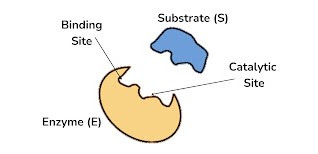What is Active Site of Enzyme – Definition and Function
Active site: Definition, Introduction, Examples, and Functions:
Active site Definition:
- The active site is defined as it is the region of an enzyme where substrate molecules bind and undergo a biochemical reaction through the catalytic site.
What is active site of enzyme in biology?
- The site of an enzyme where a catalytic reaction occurs when the enzyme and substrate specifically bind to each other.
- A region on an enzyme molecule that catalyzes a reaction is known as the active center of the enzyme.
- The active site of the enzyme is formed by the folding pattern of the protein.
- Most of the enzymes have only one active which catalyzed the corresponding substrate only.
- The active center can be divided into two sites first where the enzyme binds to the substrate (substrate-binding site ) and second catalytic site which catalyzes the chemical reaction.
- The active site determines its specificity and catalytic activity.
- Generally, the active site consists of three to four amino acid residues that form temporary bonds with the substrate (binding site) and residues that catalyze the reaction of this substrate (catalytic site).
- The efficiency of the active site depends on several factors such as temperature, pH as well as the concentration of the enzyme and substrate.
- The mechanism by which an enzyme binds substrates to its active site can be Fischer’s model known as the lock and key model or the Koshland model known as an induced fit model and by the conformational selection model.
- The denaturation of enzymes is usually caused by changes in the shape of the active sites of enzymes due to high temperature or extreme pH.
- The inhibitors of the active site will affect the binding rate of the substrate and the enzyme.
Frequently Asked Questions on Active Site:
1. What is the active site of an enzyme?
Answer: The active site is the region of an enzyme where the substrate bind and undergoes a chemical reaction. The active site determines its specificity and catalytic activity. Generally, the active site consists of three to four amino acid residues that form temporary bonds with the substrate (binding site) and residues that catalyze the reaction of this substrate (catalytic site).
2. What is an active site’s simple definition?
Answer: The active site is the region of an enzyme where substrate molecules bind and undergo a biochemical reaction.
3. How many amino acids are in the active site?
Answer: Typically, the active site consists of three to four amino acids, while the other amino acids in a protein are essential to maintain its tertiary structure.
4. What is the catalytic center of an enzyme?
Answer: The catalytic center is the part of the enzyme molecule that is responsible for its catalytic function. In two-component (complex) enzymes, a prosthetic group or coenzyme acts as a catalytic center.
5. What types of amino acids are found at active sites?
Answer: Typically, the active site consists of three to four amino acids out of 20. But more commonly it consists of histidine, arginine, asparagine, aspartic acid, carnitine, etc.
6. How is an active site formed?
Answer: The active site is formed by the folding pattern of the protein.
7. What conditions affect the activity of the enzyme center?
Answer: The efficiency of enzyme action depends on several factors: temperature, pH of the medium as well as the concentration of the enzyme and substrate.
8. What’s the difference between an active site and a binding site?
Answer: The important difference between an active site and a binding site is that an active site performs the catalysis of a biochemical reaction whereas a binding site performs the binding of a substrate molecule.

